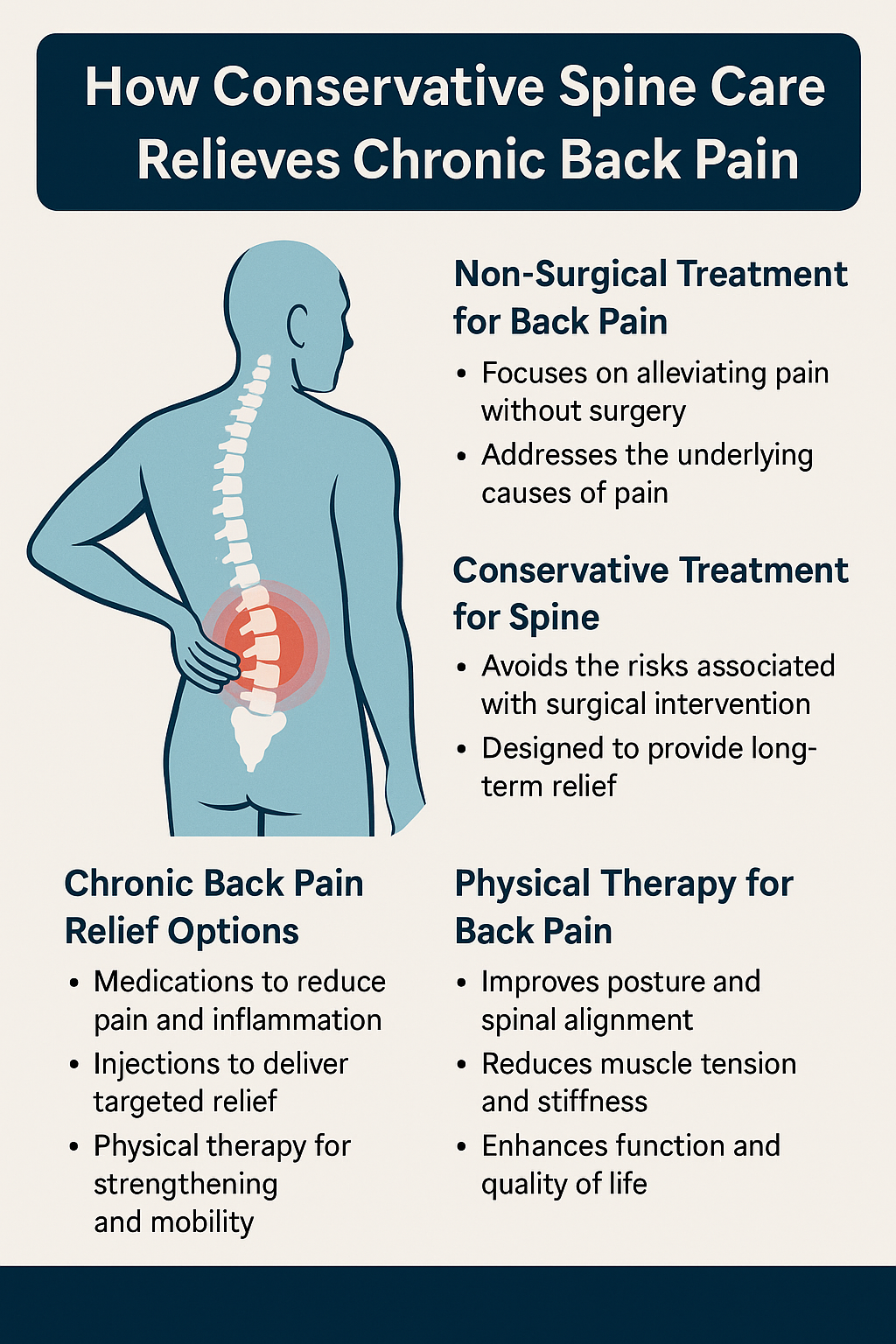How Conservative Spine Care Relieves Chronic Back Pain

Strong 8k brings an ultra-HD IPTV experience to your living room and your pocket.
Chronic back pain affects millions of people globally, often interfering with daily routines, limiting mobility, and decreasing quality of life. Many people believe surgery is the only long-term solution for back pain. However, conservative spine care—a non-surgical approach—has helped countless patients relieve chronic discomfort and regain control of their lives.
At Dallas Orthopedic Associates, we prioritize personalized, non-invasive treatment options that are safe, effective, and rooted in clinical expertise. Whether you're experiencing persistent lower back pain or early signs of spinal degeneration, our conservative care solutions are designed to help you avoid surgery whenever possible.
What Is Conservative Spine Care?
Conservative spine care refers to non-surgical treatments designed to relieve back pain, improve spinal health, and restore mobility. The focus is on addressing the root cause of the pain through non-invasive techniques, with the goal of managing symptoms, correcting imbalances, and improving quality of life.
These treatments are ideal for people dealing with:
- Chronic back pain
- Degenerative disc disease
- Muscle strain
- Sciatica
- Herniated or bulging discs (in early stages)
Who provides conservative care?
A combination of healthcare providers may be involved in your treatment plan, including orthopedic doctors, physical therapists, chiropractors, and pain management specialists. At Dallas Orthopedic Associates, our spine specialists work collaboratively to provide holistic, integrated care tailored to your needs.
Why Choose Non-Surgical Treatment for Back Pain?
Not all spine issues require surgery—and not all patients benefit from invasive procedures. In fact, a large percentage of chronic back pain cases can be effectively managed through conservative treatment.
Here’s why non-surgical spine care is often the first—and best—option:
Lower Risk: Avoid complications associated with surgery, such as infections or nerve damage.
Faster Recovery: No incisions mean quicker healing and less downtime.
Cost-Effective: Non-surgical treatments are generally less expensive and often covered by insurance.
Customizable: Treatment plans can be tailored to your lifestyle, physical limitations, and progress.
In many cases, early intervention with conservative care helps prevent the need for surgery altogether.
Which Conservative Treatments Are Most Effective?
There are several proven conservative treatment options for chronic back pain. At Dallas Orthopedic Associates, we begin with a thorough diagnosis to determine the right combination of therapies for your condition.
1. Physical Therapy
A cornerstone of conservative spine care, physical therapy focuses on:
Strengthening the core and back muscles
Improving flexibility and spinal alignment
Teaching posture and body mechanics to avoid reinjury
2. Medication
For immediate relief, over-the-counter or prescription medications may be used:
Non-steroidal anti-inflammatory drugs (NSAIDs)
Muscle relaxants
Topical analgesics
These medications reduce inflammation and alleviate pain, especially in the early stages of treatment.
3. Manual Therapy and Chiropractic Care
Spinal manipulation and soft tissue mobilization can help realign the spine, reduce stiffness, and release muscle tension. Chiropractic adjustments can improve mobility and relieve nerve pressure.
4. Epidural and Corticosteroid Injections
For severe inflammation, injections can provide targeted relief. These are often used in combination with physical therapy for maximum benefit.
5. Lifestyle and Ergonomic Adjustments
Small changes can make a big difference:
Maintaining a healthy weight
Practicing good posture
Modifying daily movements and workspaces to reduce strain
6. Support Devices
Back braces or lumbar support belts may be used to stabilize the spine and prevent worsening of the condition during healing.
How Physical Therapy Plays a Central Role in Back Pain Relief
Physical therapy is often the first line of treatment for chronic back pain—and for good reason. A well-designed physical therapy program strengthens the body’s support system and addresses mechanical causes of pain.
At Dallas Orthopedic Associates, our physical therapy programs include:
Customized Exercise Plans: Tailored to improve strength, balance, and flexibility
Posture Training: Prevents repetitive strain and encourages healthy spinal alignment
Pain Relief Techniques: Including heat/cold therapy, stretching, and mobilization
Education: Empowering patients with tools and knowledge to manage symptoms at home
Physical therapy not only relieves pain but also reduces the risk of recurrence.
When Is Conservative Spine Care the Right Option?
Conservative care is typically the first treatment approach for most back pain unless there are clear signs that surgery is urgently required (such as loss of bladder function or severe nerve compression).
Conservative treatment is recommended for:
Mild to moderate back pain lasting more than a few weeks
Pain due to muscle strain, poor posture, or minor disc issues
Patients who prefer non-invasive methods before considering surgery
Individuals with multiple health conditions who may be poor surgical candidates
Advanced imaging such as MRI or X-rays can help your doctor determine whether a conservative approach is safe and appropriate.
Ready to Relieve Your Chronic Back Pain Without Surgery?
If you’ve been living with back pain for weeks, months, or even years—don’t wait for it to get worse. The earlier you start conservative treatment, the more likely you are to avoid invasive procedures and regain your quality of life.
Dallas Orthopedic Associates is here to help you take the first step toward lasting relief.
Schedule a Consultation Today
Our experienced specialists will evaluate your condition and recommend a personalized conservative treatment plan to get you moving pain-free again.
Frequently Asked Questions (FAQs)
1. What is the difference between conservative spine care and surgical treatment?
Conservative spine care includes non-surgical treatments like physical therapy, medication, chiropractic care, and lifestyle adjustments, while surgical treatments involve procedures like spinal fusion or discectomy. Conservative care is usually tried first unless surgery is immediately necessary.
2. How long does it take for conservative treatments to relieve back pain?
Relief can vary depending on the condition, but many patients begin noticing improvements within 4 to 6 weeks with consistent therapy and follow-ups.
3. Is physical therapy really effective for chronic back pain?
Yes, physical therapy is one of the most effective conservative treatments. It strengthens core muscles, improves posture, and reduces pain over time.
4. Can I avoid surgery with conservative treatment?
In many cases, yes. Early intervention through conservative care can prevent the need for surgery, especially in non-severe spine conditions.
5. What conditions can conservative care treat?
Common conditions include herniated discs (mild to moderate), sciatica, spinal stenosis, degenerative disc disease, and muscle strain.
6. Are chiropractic adjustments safe for back pain?
When performed by licensed professionals, chiropractic adjustments are safe for most people and can offer relief by improving spinal alignment and reducing pressure on nerves.
7. Is conservative treatment covered by insurance?
Most insurance plans cover non-surgical spine care, including physical therapy, pain management, and medications. It's best to confirm with your provider.
8. Can conservative spine care help with lower back pain only?
No, conservative treatments can help with pain in all regions of the spine—cervical (neck), thoracic (upper back), and lumbar (lower back).
9. What lifestyle changes can I make to support my recovery?
Maintain a healthy weight, practice good posture, use ergonomic furniture, stay physically active, and avoid prolonged sitting or heavy lifting without support.
10. When should I see a doctor for back pain?
See a spine specialist if you experience persistent pain lasting longer than a few weeks, pain that radiates to your legs, numbness, weakness, or trouble with bladder/bowel control.
Disclaimer
Medical Disclaimer:
This blog post is for informational purposes only and does not constitute medical advice. It is not intended to diagnose, treat, cure, or prevent any condition. Always consult with a licensed healthcare provider or spine specialist before starting or changing any treatment plan. The professionals at Dallas Orthopedic Associates are available to guide you through safe and effective options tailored to your specific health needs.
Note: IndiBlogHub features both user-submitted and editorial content. We do not verify third-party contributions. Read our Disclaimer and Privacy Policyfor details.







